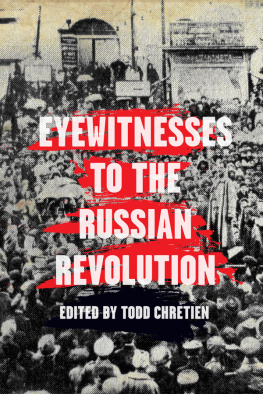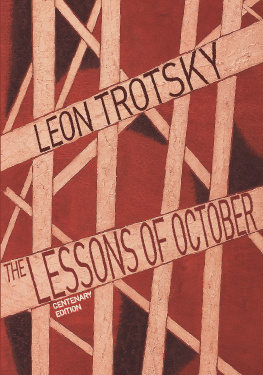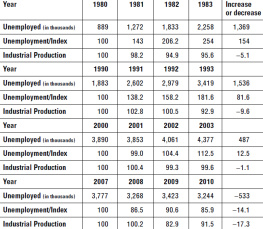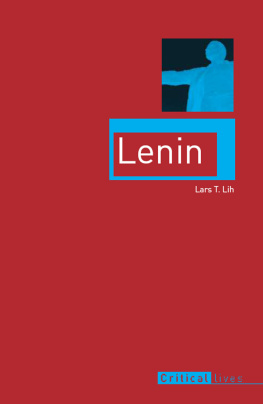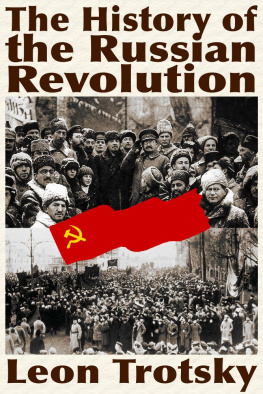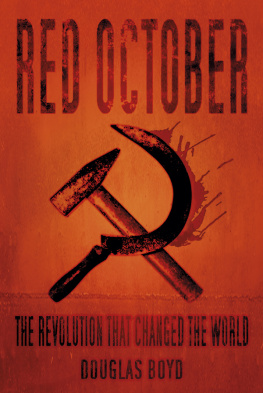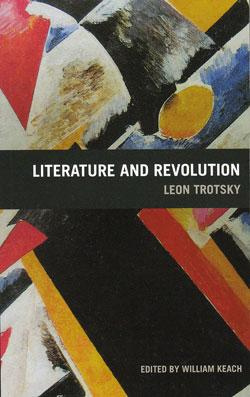EYEWITNESSES
TO THE
RUSSIAN
REVOLUTION
EYEWITNESSES
TO THE
RUSSIAN
REVOLUTION
Edited by Todd Chretien

Haymarket Books
Chicago, Illinois
2017 Todd Chretien
Published in 2017 by
Haymarket Books
P.O. Box 180165
Chicago, IL 60618
773-583-7884
www.haymarketbooks.org
ISBN: 978-1-60846-880-5
Trade distribution:
In the US, Consortium Book Sales and Distribution, www.cbsd.com
In Canada, Publishers Group Canada, www.pgcbooks.ca
In the UK, Turnaround Publisher Services, www.turnaround-uk.com
All other countries, Ingram Publisher Services International,
This book was published with the generous support of Lannan Foundation and Wallace Action Fund.
Cover design by Rachel Cohen.
Library of Congress Cataloging-in-Publication data is available.

To Isabela,
Who separates fact from fiction
ACKNOWLEDGMENTS
Over the years, many people have contributed to my appreciation of the Russian Revolution of 1917 and I owe them all a debt of gratitude. When I was in high school, Jean Souliere and Betsy Sweet made it possible for me to join a youth delegation to travel across the Soviet Union in 1987. A year or so later, Phil Gasper first acquainted me with a revolutionary Marxist analysis of Stalinism. In 1990, while I was renting a room in Colonia Mximo Jerez in Managua, Nicaragua, Mirna Gomez lent me a collection of Lenins writings en espaol to help me learn vocabulary. Although I still lacked an outline of the revolutions basic narrative, I was intrigued enough to underline evocative words in State and Revolution (such as lucha) and work my way through sentences like es ms agradable y ms provechoso vivir la experiencia de la revolucin que escribir acerca de ella. All the same, during those months, I absorbed a degree of skepticism with regard to the Great October Revolution from S., a Soviet cultural attach on assignment in Managua, over home-cooked dinners with his family.
In 1991, I moved to New York City just as George H.W. Bush invaded Iraq. I joined the Barnard/Columbia Antiwar Coalition. There I had the good fortune to meet a dedicated core of organizers and to be introduced to socialists and communists, who convinced me of the importance of understanding the Russian Revolution as a precondition to making heads or tails of the state of global politics. Leon Trotskys My Life, The Revolution Betrayed, and The History of the Russian Revolution burned away my foggy notions of really existing communism. Sherry Wolf, Eric Fretz, Barbara Kancelbaum, and Pete Gillard teamed up to win me over to Trotskyism with books and pamphlets by writers like Tony Cliff and Chris Harman. Nightly subway rides on the 2 train back to Brooklyn with Lee Sustar and long-running discussions with Tristin Adie dramatically accelerated my learning curve.
Since then, discussions and debates with too many comrades to name have enriched and enhanced my view of the revolution and those exchanges have influenced the choices I have made in this anthology. Special thanks go to: Anthony Arnove for proposing this project and providing kindly, if insistent, encouragement along the way; Jessie Muldoon for insisting on the centrality of the theory of permanent revolution and Lenins approach to national liberation; Ahmed Shawki for advice on the manuscript; Paul DAmato for lending hard-to-find books; Eric Blanc for helpful source suggestions; John Riddell for innumerable insights into Bolshevik history; Ragina Johnson for helping me understand this books audience; Nisha Bolsey for her consummate professionalism; Rachel Cohen for the beautiful book cover; and the tireless staff at Haymarket Books for their second-to-none design, editing, and promotional work.
Specifically, with regard to content, this book would not have been possible without the incredible work of the Marxist Internet Archive and their permission to use online versions of various texts as the starting basis for many of the selections in this book. Special thanks are due to David Walters on this score and to Brian Baggins, whose chronology of 1917 I used as a starting point for my own. I unreservedly encourage anyone reading this book to go to www.marxists.org to browse their invaluable archives and contribute whatever financial support or volunteer efforts you can. Many of the selections in this anthology are in the public domain, but the following publishers graciously granted permission for selections from the following works: Haymarket Books for Trotskys History of the Russian Revolution; Pluto Press for The Bolsheviks and the October Revolution: Minutes of the Central Committee of the Russian Social-Democratic Labor Party (Bolsheviks), August 1917February 1918, translated by Ann Bone; New Park Publications Ltd/Indexreach Ltd (Index Books) for F.F. Raskolnikov, Kronstadt and Petrograd in 1917; Princeton University Press for Nikolai Nikolaevich Sukhanov, The Russian Revolution of 1917: A Personal Record by N.N. Sukhanov, translated by Joel Carmichael; and Orion Publishing Group for Isaac Nachman Steinberg, In the Workshop of Revolution.
A NOTE ON THE TEXT AND SOURCES
In the early years of the Russian Revolution, English-language sources transliterated unfamiliar places and names unsystematically: Lenine and Trotzky are easy enough to figure out, but names like Nikolay Chkheidze, as you can imagine, went through various derivations. Where it is not confusing or misleading, I have left the original renderings because, I believe, the struggle with nomenclature goes to show how the Revolution took the international movement by surprise. I have left syntactical mashups in their original form for much the same reason, as they demonstrate the haste with which many writers dashed off their accounts. On the other hand, if errors appear to be later editorial concoctions or if they are unduly confusing, I have corrected them. Additionally, I have lightly edited British English to conform to American English as well as other minor corrections for consistency and meaning.
In order to adapt shorter sections of much longer works, I have cut and spliced a great deal of material. My approach has been to maintain the coherence of eyewitness reports while controlling for length and repetition. Unless noted with an italicized subheading, all selections have been made within single articles, interviews, documents, or chapters of books. In order to signal where I have interrupted an authors text, I use ellipses as follows: three dots to indicate missing words within a single sentence; three dots in brackets [] to indicate a missing section (that is, a gap consisting of sentences or whole paragraphs or sections that I have cut out); and four dots followed by a space to indicate missing words at the end of a sentence.
I have kept endnotes to a bare minimum, generally using them only to refer to secondary sources. I have decided not to burden the text with explanatory notes, either at the bottom of the page or in the endnotes. My reasoning is that context is usually enough to make the names and places meaningful. Where there is ambiguity or it might lead to confusion, I have inserted editorial comments in brackets [like this].
I have included an extensive chronology and glossary of characters, parties, and events at the end of the book. For those unfamiliar with the general history of 1917, I would suggest reading my introduction and then glancing through the chronology to get a sense of key events.
Next page
